How big do you want to go? We look at some of the biggest trailerable alloy boats on the local market and offer some hints on what to look for when checking out the many brands and models.
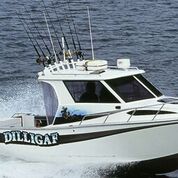
In recent years, there has been a real growth in big alloy trailer boats and if you are looking for a boat around 7m – 8m, there are plenty of chooses. The majority are hardtops and the choice of power is either twin outboards or diesel sterndrives. But what if even that isn’ t big enough and you want something the falls in that space between a big trailer boat and small launch. When you start to research what is available around 10m plus you have to consider a whole new set of criteria.
Firstly there is the question of towing, or perhaps not. While it’ s entirely possible to get a 10m x 2.5m beam hull, the fact is that’ s too narrow in the beam and most designers would opt for aminimum of 2.8m and above. This then brings up the question of towing regulations, which with a boat this size takes in overall length, beam and weight.
The rules are reasonably simple if you keep the beam below 3m, but start creeping over that and you have yourself a whole lot more things to consider when you’ re towing. But more on that later. So more often than not the majority of alloy boats over 10m are over 3m so need to be moored, or at least kept on a dry stack. This has the added benefit of not requiring a trailer and the $30,000 to $40,000 saved here goes a long way into the cost or a marina berth or dry stack rental.
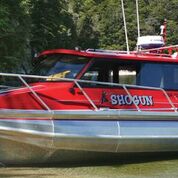
Things to Consider
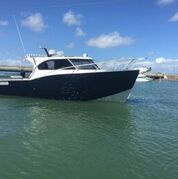
Buying a trailer boat over 10m is not a lot different to buying one at 5m, it’s just things are compounded by volume and weight. In both cases, you have some things to consider, such as storage, towing, power, suitability and of course, cost. While cost is a consideration when buying a big trailer boat, it is perhaps not as important as someone buying a more entry level rig. Boats vary widely in price and to put a 10m plus alloy hardtop boat on the water can cost you $300,000 to more than $600,000.
It all depends on who’ s building it and just how far you want to go with the engineering, painting and electronics fit out. Your power options will have a significant impact on the final cost also. While a pair of 250-300hp outboards will set you back around $80,000, a 350-400hp diesel sterndrive is going to run to upwards of $90,000. Electronics in boats of this size are more than just a $400 fishfinders and again 12’ -16” MFD screens and all the associated add-ons such as a 1000w transducer, radar, night vision, EPIRBS, etc. can run well over $20,000.
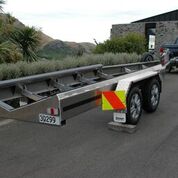

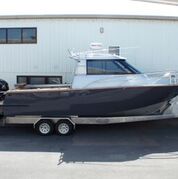
If you do plan to tow you big rig, then you will require something seriously grunty to tow it. Diesel 4WDs are certainly the most popular and while most, such as the Ford Ranger, Isuzu D-Max and Holden Colorado are rated to 3500 kgs, you are going to need something a lot bigger if you plan to put your 10m plus boat on the road. Big ’ trucks’ such as those offered by Ford, GM and Dodge are now readily available through dealers and provide the power and braking ability for big trailer boats. For example a Ford F150 has a tow rating of 5,500 kgs and a Dodge Ram 250/6.7 l Cummins diesel has a capacity of 8155 kgs.
Towing Regulations
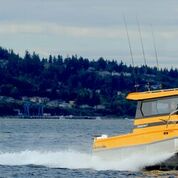
While on the subject of tow ability, it’s probably a good time to look at some of the things you need to know about towing. The New Zealand Land Transport Agency (www.nzta.govt.nz) is a good place to start. Big trailer boats require big trailers, mostly tandem but even triple axle with brakes and all the necessary security attachments. Today it is not uncommon to see trailer boats advertised with beams more than the legal maximum in New Zealand of 2.5m. However, getting a special permit to tow an over-width vehicle up to 3.0m is not an important issue.
All it means is you have to carry some extra signage at the rear of the trailer and you will have some restrictions on the hours you are allowed to tow. Simply plan your trips and the inconvenience will be quickly outweighed by the benefits of having your boat where you want it. If your rig is over 3.0m wide, you start getting into all sorts of complications with special permits, pilot vehicles, etc. No matter what size your rig, a speed limit of 90km/h applies.
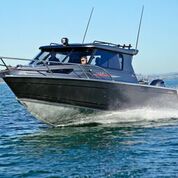
Designed for a Purpose

Every boat is different and not all are designed to do the same thing. While one offers vast accommodation and entertaining spaces, another may have a massive cockpit that lends itself to fishing. You may want a boat that offers more of the overnighting and extended stay aspects, as opposed to one that is designed for hardout fishing. In most cases, but not all, they are aluminium hardtops. The dividing line is usually between having a wheelhouse, often enclosed, with a small bunk area forward and a big workable cockpit.
New Zealand has certainly developed the
enclosed hardtop trailer boat better than virtually anywhere else in the world. They are now an iconic part of our local boating culture. It’s not uncommon to see air conditioning and heating systems inside, so the boat becomes an all-year, all-weather experience.
Dinettes, galleys and enclosed heads are all the norm now, especially when you are looking boats over 10m. Anyone who boats in the Deep South will appreciate the benefits of an enclosed wheelhouse during the winter and the addition of a heating system. If you are not into serious fishing and want more of a compact cruiser, then there are a number of brands and models to look at, although when it comes to alloy, these are commonly custom built.
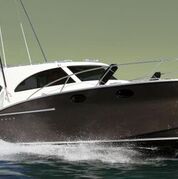

That’ s the beauty of aluminium, you can change a basic layout to suit what you require, such as having an internal or external toilet, the size of the galley, the length of the wheelhouse and whether the table drops to make another berth. Firstly it should have accommodation for at least two and even better for four or even six. Generally, an average size cabin has twin berths of around 1.8m to 2m in length. Some have the bonus of an infill to transform that entire cabin area into one huge berth and something we are seeing a lot more now are retractable pipe berths.
It must have a galley or at least some reasonable cooking area to prepare a meal for all aboard and it must have a head/toilet. A true weekender that has been purpose designed for the job will also have a shower although this maybe just a hand-held in the cockpit. Hot water can be accessed via a califont or by plumbing into the engine (both inboard and outboard) and there’ s usually plenty of space somewhere in the construction to build in a reasonable large fresh water tankage system.
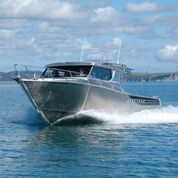
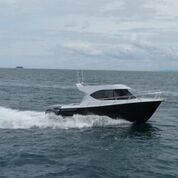
If you have a clip-on backdrop from the canopy, then the whole cockpit can be transformed into one cosy cabin. If you are planning on doing a bit of overnighting, then a backdrop is well worth considering. So what about cooking? In most cases a boat over 10m will have a dedicated galley, with all the hot and cold water options on hand and a compact convection microwave oven with a couple of gas burners. If the boat doesn’t have a galley, then the simplest way is probably a barbeque, such as a small gas BBQ with a rod holder mount and wind deflectors.
There are some excellent brands available, such as Magna, specially designed for the purpose. Food storage is another important area to consider, especially if you’ re not a fisherman and don’ t plan to fill your culinary needs from the sea. Even then your best efforts may prove fruitless (should that be fishless?) – and a nice juicy steak might just save the day. Again if you don’ t have a built-in freezer/fridge, then one of the large portable ice chests from brands such as Engel will do the job nicely. You can get ones that plug into the auxiliary plug and run a small compressor to chill everything down or simply toss in some ice.
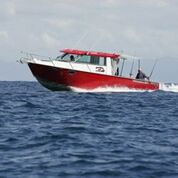
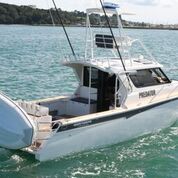
These come in a variety of sizes to suit the space you have available and depending on just how many times you open and close the lid they can keep things cold and fresh for a remarkably extended period. Of course, as the food and drink go, you can always fill the space with fresh seafood to take home. As for the toilet issues, if you want to do everything by the letter of the law then you need to install a fully plumbed head or have a portable loo. While the ‘ bucket and chuck it’ method always worked well in the past, it is, in fact, illegal to dump human waste into the bay unless you are well offshore.
Consider having your toilet compartment in the cockpit, as there is nothing worse than toilet odours eminating throughout the wheelhouse. Lighting is another area that you need to consider if you want to keep a nice ambient feeling aboard the boat. Just be conscious of the power they are drawing, so you don’ t end up in the morning with flat batteries. This is where the low draw of an LED comes into its own and is great in this type of situation. Hella make a range of excellent LED cabin and cockpit lights which can both light up the fishing and interior space or just provide some ambient light.
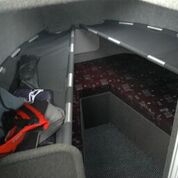
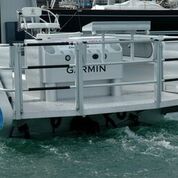
This is where the low draw of an LED comes into its own and is great in this type of situation. Hella make a range of excellent LED cabin and cockpit lights which can both light up the fishing and interior space or just provide some ambient light. Floodlights are great when fishing at night, as are underwater lights. Aqualuma is one of the world leaders in underwater lights and their new units are ideally suited to flush fitting into the hull or can be mounted onto the trim tabs.
They not only look good when you are parked in the bay at night but they also act as a fish attractor. Perfect for whitebait and also squid seem to be drawn to them. Then there is the question of having enough onboard power to run all those extras. Although modern engine alternators are supplying greater battery charging, those who tend to use more lighting and TVs and appliances should look into solar chargers, inverters, or even a small generator. Your battery bank should include at least two batteries, one to start the engine(s), the other to run the electronics.
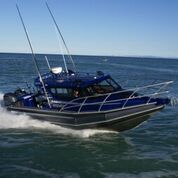
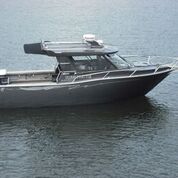
However, if you are planning to be away for extended periods, unless you constantly run the engine you will soon go short on power. Having a small compact genset might be worth considering or maybe talk to AA Solar about solar panels to keep the batteries topped up.

Plenty of Power
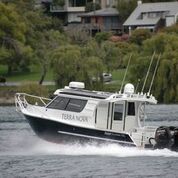
We are fortunate today that the outboard manufacturers are producing seriously big outboards with the power needed to bolt onto the transom of big boats. 300hp-350hp outboards have been around for some time and now there are 400hp stickers on the side of some cowlings. The benefit of the big outboards is that you no longer need to rely on twin midrange engines to achieve the necessary horsepower to gain the best performance.
While a lot of boats are still sold with twin six-cylinder outboards, there is an increasing number being launched with diesel sterndrives. At the end of the day the boat you buy and the engine package you choose is your decision, but make certain that what you buy is suitable for your purpose. Also, if you like a particular brand and you can’ t find a 10m plus model in their brochure, then asked the manufacturer. There’ s a good chance they will oblige and build you exactly what you want.





